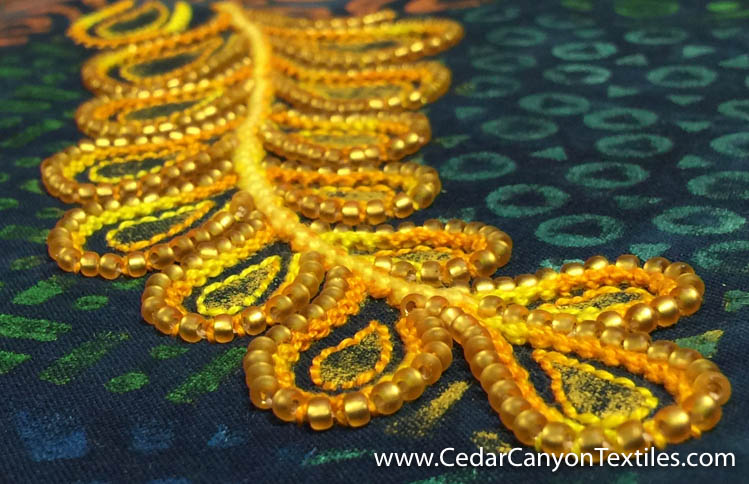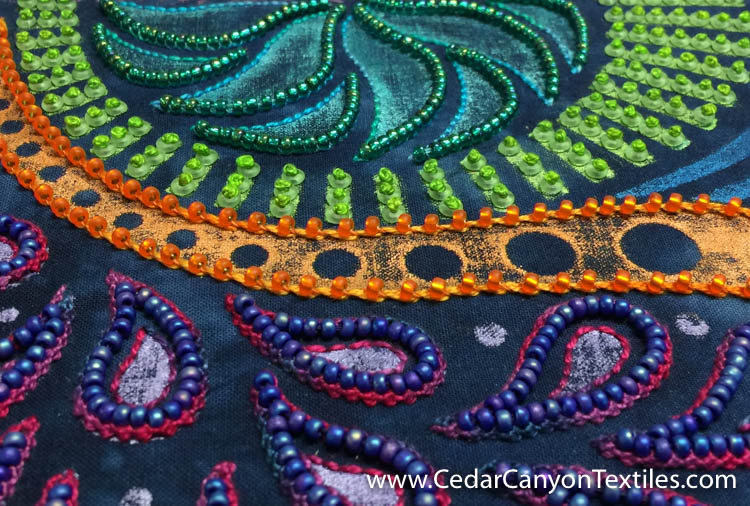Journal
Permission to Stop

[vc_row][vc_column][vc_column_text]
The last time I sat down to stitch on my Paint-Stitch-Bead project, I knew in my heart it wasn’t worth finishing. Parts of it are fantastic. But as a whole, there are too many things I would do differently if I started over today.
Can I be really honest? It’s really hard for me to stop. There’s a bunch of old messages floating around in my head. “If it’s worth doing, it’s worth doing well.” “Don’t be a quitter.” And on and on and on…
[Tweet “Why is it so hard to give ourselves permission to stop?”]
So, let me ask you a question. Why is it so hard for use to give ourselves Permission to Stop? Why is it so hard to admit that no amount of stitching is going to make this design better than it is? Why is it easier to plunge ahead instead of pulling the plug?
Permission to Stop
As I pondered this topic, I realized a couple of important things. Stopping (with intention) is not the same thing as quitting or giving up.
For me, quitting and giving up are cop outs. It’s a sign that I don’t want to work that hard or that I lack the confidence to figure something out. (And believe me, there are precious few things I can’t figure out if I put my mind to it!)
But intentionally choosing to stop? That’s an option. Here’s the thought process I went through as I considered giving myself permission to stop:
The Good, the Bad and the Bottom Line
First the good:
This piece absolutely served it’s intended purpose – and more. It was part of a series of experiments to help me refine my Peel & Paint collage painting technique. It served as a great sample for my Whole Cloth Collage class. Better yet, it served as a great jumping off point for my new journey of adding beads to my Stitched Paintings.
Now the not-so-good:
This piece would require some significant camouflage work to overcome some poor color choices. The composition is okay, but nothing to write home about. More important, I’ve learned a lot about ways to add visual dimension to a project like this, and I would make some major changes if I were to start over today.
So, what’s the bottom line?
I’m giving myself Permission to Stop – and to appreciate all the good things that came from this wonderful experiment.
I appreciate the conversations with my Whole Cloth Collage students and the pieces they painted during the class. They inspired me to explore different ways to create visual dimension. And, to be honest, I might not have headed down that path had we not had those conversations.
By stopping now, and allowing my experiment to remain exactly that, I can start over with intention. Starting over will allow me to incorporate the things I’ve learned, and save the hours of stitching and beading for a piece that is worthy of the time and energy that goes into it.
I’ve enjoyed spending time with this experiment, but it’s time to move on. Or perhaps I should say it’s time to move up – to use this as the basis for a project that makes my heart sing. Permission to stop, permission to appreciate the lessons, permission to move forward. All good.
Your Turn
When is the last time you gave yourself Permission to Stop? Was it a project that wasn’t working? A technique you just didn’t like? Do you struggle with this like I do?
Leave your thoughts in a comment below. I’m curious to know what you’re thinking.[/vc_column_text][/vc_column][/vc_row]








I’m curious – if “[p]arts of it are fantastic”, is there a way for you to take just those parts and make something else with them? Or is it better to leave it as is as a sample, or experiments, or whatever? I’m not suggesting that you shouldn’t stop, just posing the question of doing something different with the good parts.
That’s exactly my plan, Cheryl. I’m most likely to cut this up and “finish” the two small sections I’ve been stitching and beading on so far. They really are precious, and they will make lovely stand-alone small works.
I find it difficult to stop reading a book I don’t like, so I totally get this! It is a problem with us A types I think. I have given myself permission to stop on one project that is about 16 years old! I had the great idea to do a “Picture” quilt of my back yard looking up towards my home. The sketch was pretty darn good. I finally realized that back then I was buying cheapo fabrics from chain stores, and they were not going to last long enough for me to finish. I know better now.
The other problem is that I often start without a plan. I get my inspiration as I go along. Sometimes this makes it much harder than it could have been. You have been an inspiration to me. I thank you for that! Kim
Fabulous, Kim! Letting go of that 16-year-old project is big! (I have a few of those hanging around in a bin that I need to move out of the studio in one way or another!)
I totally understand the “starting without a plan” thing. It’s good, because it’s “play” in the best sense of that word. It’s good because we learn very cool things from our experiments. The key is knowing when to let go and and put our time into something that’s “really good.”
Let me check, Mary. I’ll contact you by Email.
I was able to fix the problem with the links. Sorry about that! We had a stray character in the link and the web just didn’t know what to do with it.
The problem that I have with stopping something is that I tend to feel that I wasted my time and have nothing to show for it. I have to keep telling myself that if I learned something in the process than it wasn’t a waste of time after all! And sometimes if I leave the project for a while and come back to it, I have another idea on how to use it.
Wow. You hit the nail on the head Rebecca. That “wasted time” message is a tough one to get past. I had not thought about it in those terms, but that’s a big part of those sneaky “messages” floating around in my brain. Do we ever get past this craziness???
I too live by the “If something is worth doing, it’s worth doing well” motto which I believe is a worthwhile one to have but of late I have realised that whilst this perfectionistic attitude leads to some great accomplishments it also leads me to have great difficulties in “letting go” of things I should let go of. I too do not like wasting time or special craft supplies. I also do not like “giving up” and at times this is ridiculous as in stopping the reading of a book that I am clearly not enjoying (as Kim said above). Recently I did just this with quite some effort, having been inspired by my son’s belief that “Life is too short to waste time reading bad books”. Thanks Shelly for another thought provoking blog that speaks to me on such a deep level.
You are so welcome, Mary. And thanks for passing along the wisdom from your son! This whole “Don’t Waste…” thing that is so ingrained in us is huge.
I have a studio full of art/craft supplies that I’m holding onto because I can’t bear to waste them. But holding onto them is a huge energy drain because I feel like I “should” be doing something with them. Time for another attitude adjustment! I certainly won’t throw them away, but it’s not “waste” if I pass them along to someone who would love to use them. Right?